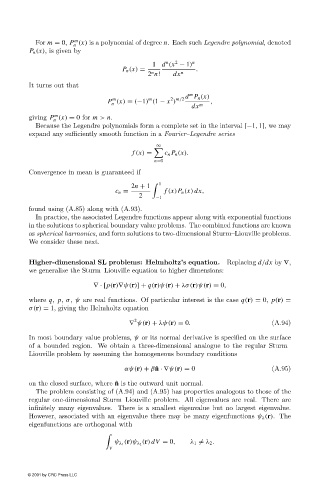Page 492 - Electromagnetics
P. 492
m
For m = 0, P (x) is a polynomial of degree n. Each such Legendre polynomial, denoted
n
P n (x), is given by
n
2
1 d (x − 1) n
P n (x) = .
n
2 n! dx n
It turns out that
m
d P n (x)
m
m
2 m/2
P (x) = (−1) (1 − x ) ,
n
dx m
m
giving P (x) = 0 for m > n.
n
Because the Legendre polynomials form a complete set in the interval [−1, 1],we may
expand any sufficiently smooth function in a Fourier–Legendre series
∞
f (x) = c n P n (x).
n=0
Convergence in mean is guaranteed if
2n + 1 1
c n = f (x)P n (x) dx,
2 −1
found using (A.85) along with (A.93).
In practice, the associated Legendre functions appear along with exponential functions
in the solutions to spherical boundary value problems. The combined functions are known
as spherical harmonics, and form solutions to two-dimensional Sturm–Liouville problems.
We consider these next.
Higher-dimensional SL problems: Helmholtz’s equation. Replacing d/dx by ∇,
we generalize the Sturm–Liouville equation to higher dimensions:
∇· [p(r)∇ψ(r)] + q(r)ψ(r) + λσ(r)ψ(r) = 0,
where q, p, σ, ψ are real functions. Of particular interest is the case q(r) = 0, p(r) =
σ(r) = 1, giving the Helmholtz equation
2
∇ ψ(r) + λψ(r) = 0. (A.94)
In most boundary value problems, ψ or its normal derivative is specified on the surface
of a bounded region. We obtain a three-dimensional analogue to the regular Sturm–
Liouville problem by assuming the homogeneous boundary conditions
αψ(r) + β ˆ n ·∇ψ(r) = 0 (A.95)
on the closed surface, where ˆ n is the outward unit normal.
The problem consisting of (A.94) and (A.95) has properties analogous to those of the
regular one-dimensional Sturm–Liouville problem. All eigenvalues are real. There are
infinitely many eigenvalues. There is a smallest eigenvalue but no largest eigenvalue.
However, associated with an eigenvalue there may be many eigenfunctions ψ λ (r). The
eigenfunctions are orthogonal with
(r) dV = 0, λ 1 = λ 2 .
ψ λ 1 (r)ψ λ 2
V
© 2001 by CRC Press LLC

